Business Taxation: Comprehensive Report on Tax Regulations and Schemes
VerifiedAdded on 2022/12/29
|12
|3689
|97
Report
AI Summary
This report provides a comprehensive analysis of business taxation, covering various aspects such as the assessment of trading profits with a practical example calculating Linda's trading profits for the year, criteria for employment versus self-employment and the reasons individuals prefer self-employment, a discussion of the six badges of trade used to determine if an activity constitutes trading, an overview of different VAT schemes for VAT-registered companies, and practical calculations of inheritance tax and capital gains tax liabilities. The report delves into the nuances of tax regulations and provides insights into how businesses and individuals can navigate the complexities of the tax system, highlighting the importance of understanding and complying with taxation requirements. Desklib offers a range of study tools, including solved assignments and past papers, to support students in their academic endeavors.
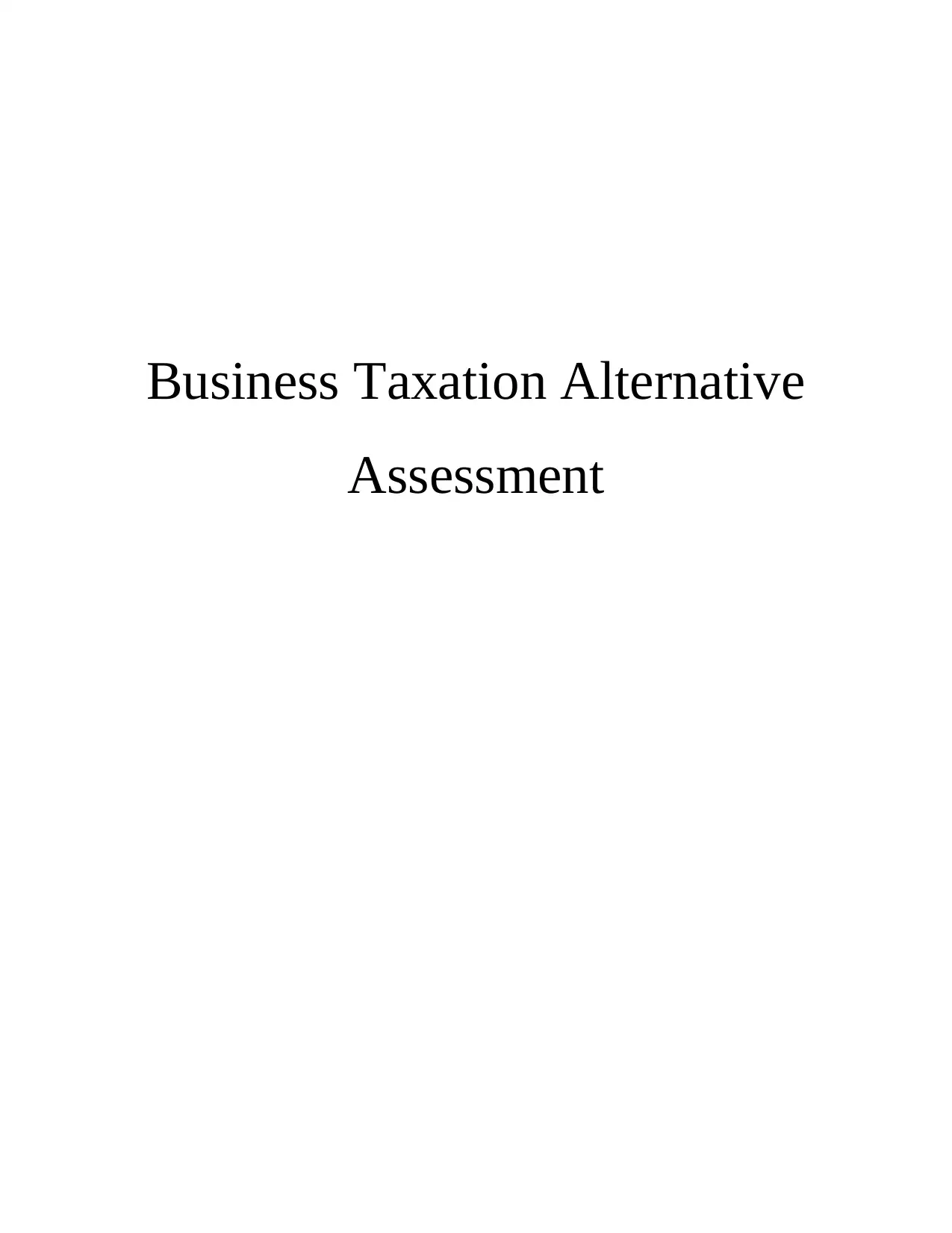
Business Taxation Alternative
Assessment
Assessment
Paraphrase This Document
Need a fresh take? Get an instant paraphrase of this document with our AI Paraphraser
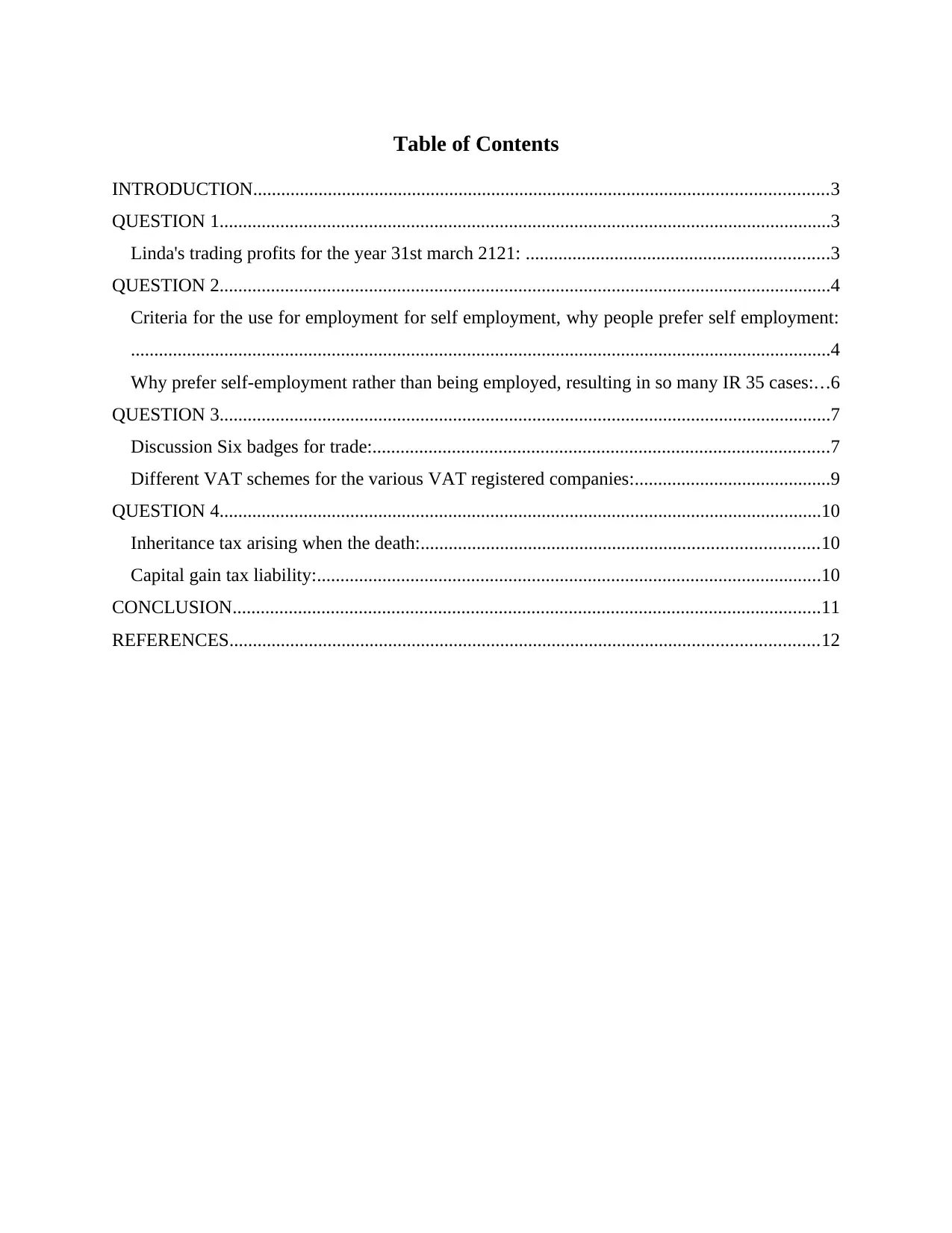
Table of Contents
INTRODUCTION...........................................................................................................................3
QUESTION 1...................................................................................................................................3
Linda's trading profits for the year 31st march 2121: .................................................................3
QUESTION 2...................................................................................................................................4
Criteria for the use for employment for self employment, why people prefer self employment:
......................................................................................................................................................4
Why prefer self-employment rather than being employed, resulting in so many IR 35 cases:...6
QUESTION 3...................................................................................................................................7
Discussion Six badges for trade:..................................................................................................7
Different VAT schemes for the various VAT registered companies:..........................................9
QUESTION 4.................................................................................................................................10
Inheritance tax arising when the death:.....................................................................................10
Capital gain tax liability:............................................................................................................10
CONCLUSION..............................................................................................................................11
REFERENCES..............................................................................................................................12
INTRODUCTION...........................................................................................................................3
QUESTION 1...................................................................................................................................3
Linda's trading profits for the year 31st march 2121: .................................................................3
QUESTION 2...................................................................................................................................4
Criteria for the use for employment for self employment, why people prefer self employment:
......................................................................................................................................................4
Why prefer self-employment rather than being employed, resulting in so many IR 35 cases:...6
QUESTION 3...................................................................................................................................7
Discussion Six badges for trade:..................................................................................................7
Different VAT schemes for the various VAT registered companies:..........................................9
QUESTION 4.................................................................................................................................10
Inheritance tax arising when the death:.....................................................................................10
Capital gain tax liability:............................................................................................................10
CONCLUSION..............................................................................................................................11
REFERENCES..............................................................................................................................12
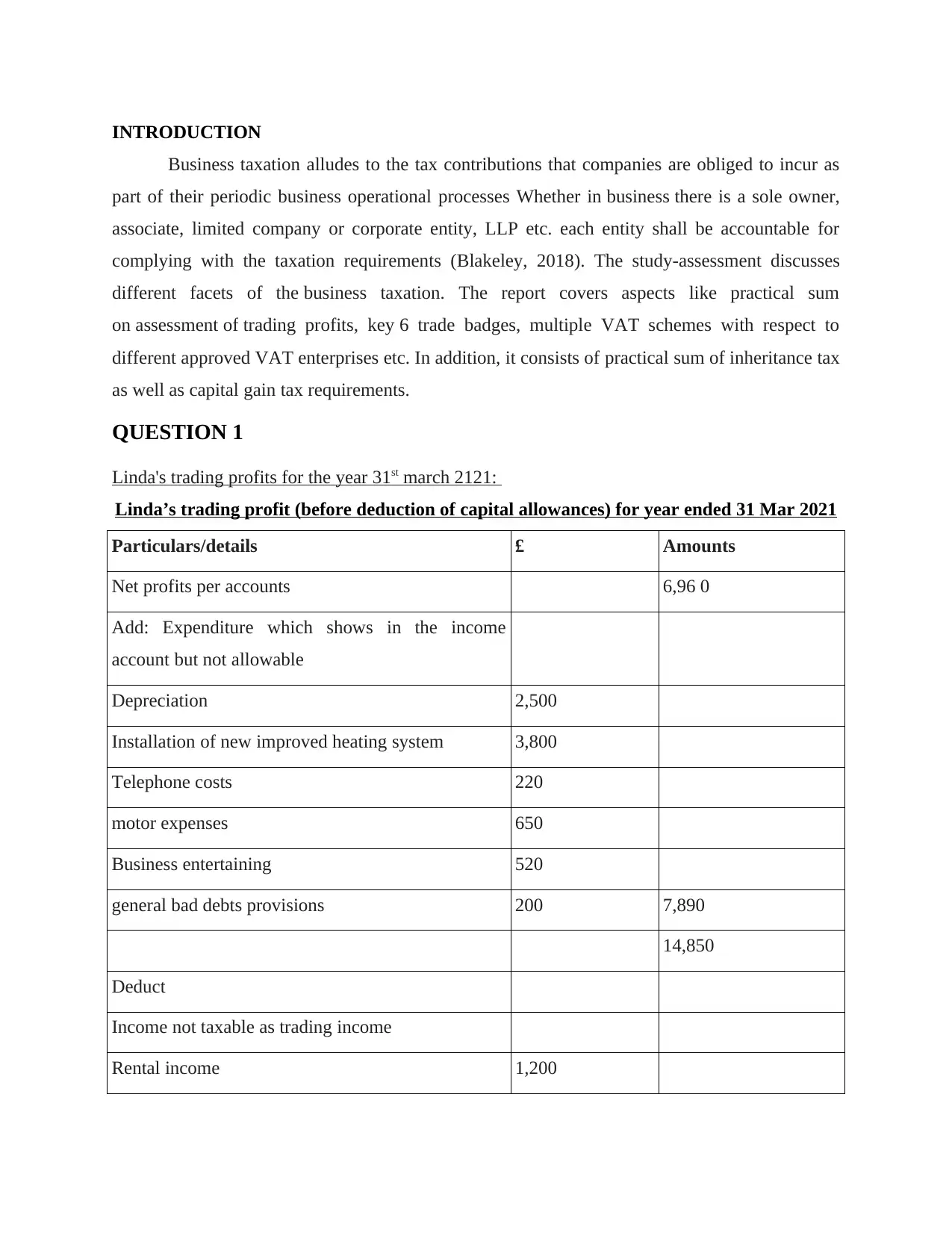
INTRODUCTION
Business taxation alludes to the tax contributions that companies are obliged to incur as
part of their periodic business operational processes Whether in business there is a sole owner,
associate, limited company or corporate entity, LLP etc. each entity shall be accountable for
complying with the taxation requirements (Blakeley, 2018). The study-assessment discusses
different facets of the business taxation. The report covers aspects like practical sum
on assessment of trading profits, key 6 trade badges, multiple VAT schemes with respect to
different approved VAT enterprises etc. In addition, it consists of practical sum of inheritance tax
as well as capital gain tax requirements.
QUESTION 1
Linda's trading profits for the year 31st march 2121:
Linda’s trading profit (before deduction of capital allowances) for year ended 31 Mar 2021
Particulars/details £ Amounts
Net profits per accounts 6,96 0
Add: Expenditure which shows in the income
account but not allowable
Depreciation 2,500
Installation of new improved heating system 3,800
Telephone costs 220
motor expenses 650
Business entertaining 520
general bad debts provisions 200 7,890
14,850
Deduct
Income not taxable as trading income
Rental income 1,200
Business taxation alludes to the tax contributions that companies are obliged to incur as
part of their periodic business operational processes Whether in business there is a sole owner,
associate, limited company or corporate entity, LLP etc. each entity shall be accountable for
complying with the taxation requirements (Blakeley, 2018). The study-assessment discusses
different facets of the business taxation. The report covers aspects like practical sum
on assessment of trading profits, key 6 trade badges, multiple VAT schemes with respect to
different approved VAT enterprises etc. In addition, it consists of practical sum of inheritance tax
as well as capital gain tax requirements.
QUESTION 1
Linda's trading profits for the year 31st march 2121:
Linda’s trading profit (before deduction of capital allowances) for year ended 31 Mar 2021
Particulars/details £ Amounts
Net profits per accounts 6,96 0
Add: Expenditure which shows in the income
account but not allowable
Depreciation 2,500
Installation of new improved heating system 3,800
Telephone costs 220
motor expenses 650
Business entertaining 520
general bad debts provisions 200 7,890
14,850
Deduct
Income not taxable as trading income
Rental income 1,200
⊘ This is a preview!⊘
Do you want full access?
Subscribe today to unlock all pages.

Trusted by 1+ million students worldwide
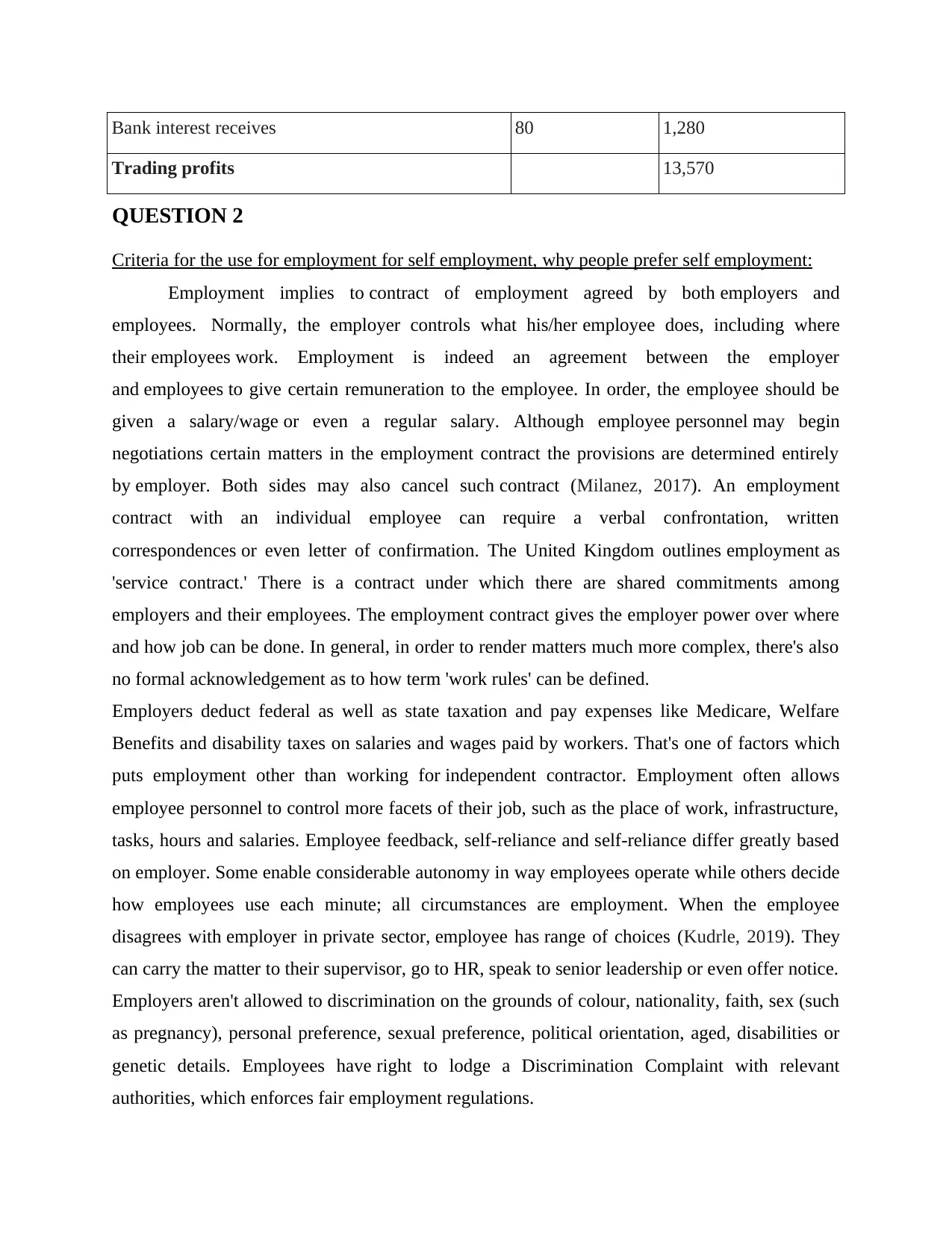
Bank interest receives 80 1,280
Trading profits 13,570
QUESTION 2
Criteria for the use for employment for self employment, why people prefer self employment:
Employment implies to contract of employment agreed by both employers and
employees. Normally, the employer controls what his/her employee does, including where
their employees work. Employment is indeed an agreement between the employer
and employees to give certain remuneration to the employee. In order, the employee should be
given a salary/wage or even a regular salary. Although employee personnel may begin
negotiations certain matters in the employment contract the provisions are determined entirely
by employer. Both sides may also cancel such contract (Milanez, 2017). An employment
contract with an individual employee can require a verbal confrontation, written
correspondences or even letter of confirmation. The United Kingdom outlines employment as
'service contract.' There is a contract under which there are shared commitments among
employers and their employees. The employment contract gives the employer power over where
and how job can be done. In general, in order to render matters much more complex, there's also
no formal acknowledgement as to how term 'work rules' can be defined.
Employers deduct federal as well as state taxation and pay expenses like Medicare, Welfare
Benefits and disability taxes on salaries and wages paid by workers. That's one of factors which
puts employment other than working for independent contractor. Employment often allows
employee personnel to control more facets of their job, such as the place of work, infrastructure,
tasks, hours and salaries. Employee feedback, self-reliance and self-reliance differ greatly based
on employer. Some enable considerable autonomy in way employees operate while others decide
how employees use each minute; all circumstances are employment. When the employee
disagrees with employer in private sector, employee has range of choices (Kudrle, 2019). They
can carry the matter to their supervisor, go to HR, speak to senior leadership or even offer notice.
Employers aren't allowed to discrimination on the grounds of colour, nationality, faith, sex (such
as pregnancy), personal preference, sexual preference, political orientation, aged, disabilities or
genetic details. Employees have right to lodge a Discrimination Complaint with relevant
authorities, which enforces fair employment regulations.
Trading profits 13,570
QUESTION 2
Criteria for the use for employment for self employment, why people prefer self employment:
Employment implies to contract of employment agreed by both employers and
employees. Normally, the employer controls what his/her employee does, including where
their employees work. Employment is indeed an agreement between the employer
and employees to give certain remuneration to the employee. In order, the employee should be
given a salary/wage or even a regular salary. Although employee personnel may begin
negotiations certain matters in the employment contract the provisions are determined entirely
by employer. Both sides may also cancel such contract (Milanez, 2017). An employment
contract with an individual employee can require a verbal confrontation, written
correspondences or even letter of confirmation. The United Kingdom outlines employment as
'service contract.' There is a contract under which there are shared commitments among
employers and their employees. The employment contract gives the employer power over where
and how job can be done. In general, in order to render matters much more complex, there's also
no formal acknowledgement as to how term 'work rules' can be defined.
Employers deduct federal as well as state taxation and pay expenses like Medicare, Welfare
Benefits and disability taxes on salaries and wages paid by workers. That's one of factors which
puts employment other than working for independent contractor. Employment often allows
employee personnel to control more facets of their job, such as the place of work, infrastructure,
tasks, hours and salaries. Employee feedback, self-reliance and self-reliance differ greatly based
on employer. Some enable considerable autonomy in way employees operate while others decide
how employees use each minute; all circumstances are employment. When the employee
disagrees with employer in private sector, employee has range of choices (Kudrle, 2019). They
can carry the matter to their supervisor, go to HR, speak to senior leadership or even offer notice.
Employers aren't allowed to discrimination on the grounds of colour, nationality, faith, sex (such
as pregnancy), personal preference, sexual preference, political orientation, aged, disabilities or
genetic details. Employees have right to lodge a Discrimination Complaint with relevant
authorities, which enforces fair employment regulations.
Paraphrase This Document
Need a fresh take? Get an instant paraphrase of this document with our AI Paraphraser
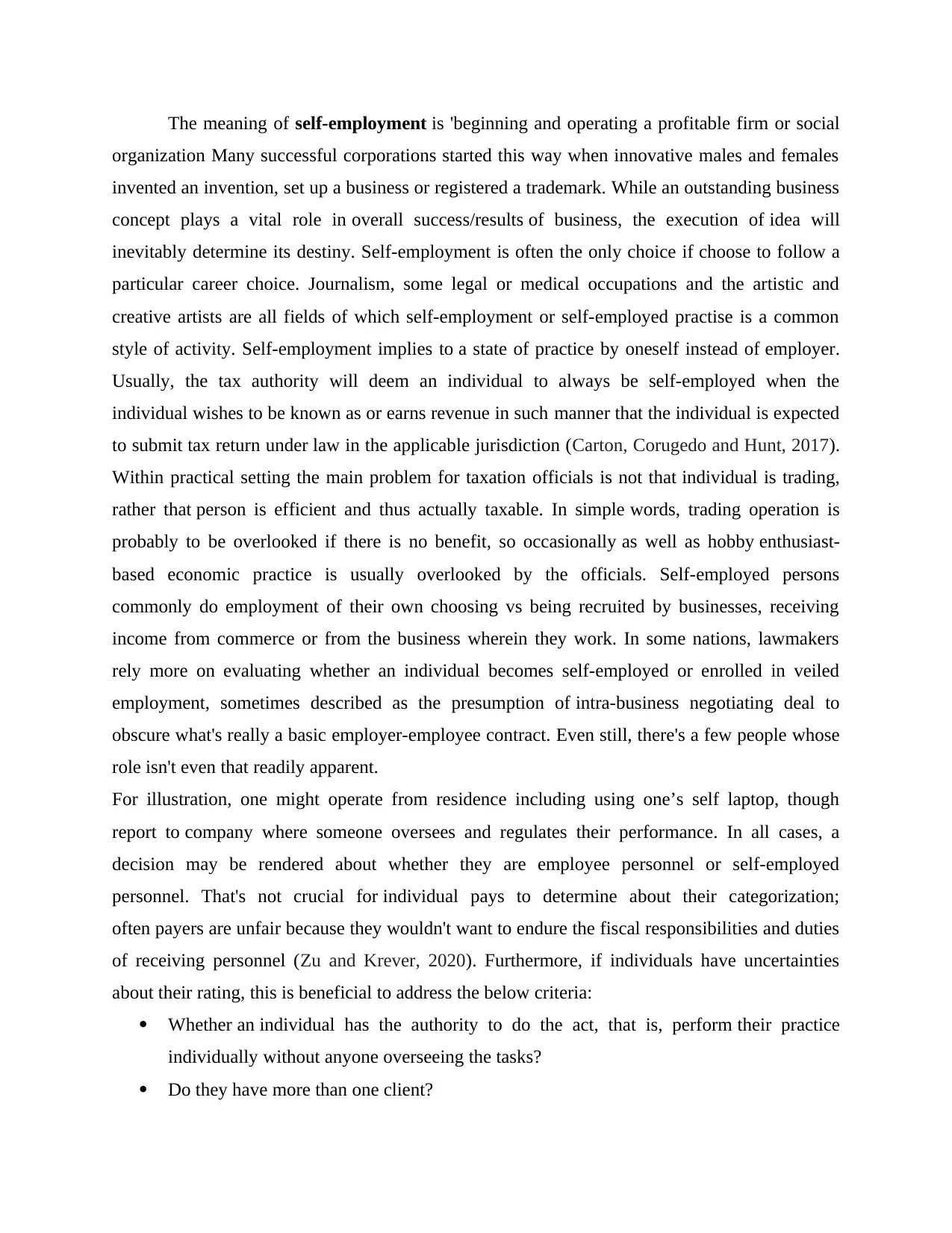
The meaning of self-employment is 'beginning and operating a profitable firm or social
organization Many successful corporations started this way when innovative males and females
invented an invention, set up a business or registered a trademark. While an outstanding business
concept plays a vital role in overall success/results of business, the execution of idea will
inevitably determine its destiny. Self-employment is often the only choice if choose to follow a
particular career choice. Journalism, some legal or medical occupations and the artistic and
creative artists are all fields of which self-employment or self-employed practise is a common
style of activity. Self-employment implies to a state of practice by oneself instead of employer.
Usually, the tax authority will deem an individual to always be self-employed when the
individual wishes to be known as or earns revenue in such manner that the individual is expected
to submit tax return under law in the applicable jurisdiction (Carton, Corugedo and Hunt, 2017).
Within practical setting the main problem for taxation officials is not that individual is trading,
rather that person is efficient and thus actually taxable. In simple words, trading operation is
probably to be overlooked if there is no benefit, so occasionally as well as hobby enthusiast-
based economic practice is usually overlooked by the officials. Self-employed persons
commonly do employment of their own choosing vs being recruited by businesses, receiving
income from commerce or from the business wherein they work. In some nations, lawmakers
rely more on evaluating whether an individual becomes self-employed or enrolled in veiled
employment, sometimes described as the presumption of intra-business negotiating deal to
obscure what's really a basic employer-employee contract. Even still, there's a few people whose
role isn't even that readily apparent.
For illustration, one might operate from residence including using one’s self laptop, though
report to company where someone oversees and regulates their performance. In all cases, a
decision may be rendered about whether they are employee personnel or self-employed
personnel. That's not crucial for individual pays to determine about their categorization;
often payers are unfair because they wouldn't want to endure the fiscal responsibilities and duties
of receiving personnel (Zu and Krever, 2020). Furthermore, if individuals have uncertainties
about their rating, this is beneficial to address the below criteria:
Whether an individual has the authority to do the act, that is, perform their practice
individually without anyone overseeing the tasks?
Do they have more than one client?
organization Many successful corporations started this way when innovative males and females
invented an invention, set up a business or registered a trademark. While an outstanding business
concept plays a vital role in overall success/results of business, the execution of idea will
inevitably determine its destiny. Self-employment is often the only choice if choose to follow a
particular career choice. Journalism, some legal or medical occupations and the artistic and
creative artists are all fields of which self-employment or self-employed practise is a common
style of activity. Self-employment implies to a state of practice by oneself instead of employer.
Usually, the tax authority will deem an individual to always be self-employed when the
individual wishes to be known as or earns revenue in such manner that the individual is expected
to submit tax return under law in the applicable jurisdiction (Carton, Corugedo and Hunt, 2017).
Within practical setting the main problem for taxation officials is not that individual is trading,
rather that person is efficient and thus actually taxable. In simple words, trading operation is
probably to be overlooked if there is no benefit, so occasionally as well as hobby enthusiast-
based economic practice is usually overlooked by the officials. Self-employed persons
commonly do employment of their own choosing vs being recruited by businesses, receiving
income from commerce or from the business wherein they work. In some nations, lawmakers
rely more on evaluating whether an individual becomes self-employed or enrolled in veiled
employment, sometimes described as the presumption of intra-business negotiating deal to
obscure what's really a basic employer-employee contract. Even still, there's a few people whose
role isn't even that readily apparent.
For illustration, one might operate from residence including using one’s self laptop, though
report to company where someone oversees and regulates their performance. In all cases, a
decision may be rendered about whether they are employee personnel or self-employed
personnel. That's not crucial for individual pays to determine about their categorization;
often payers are unfair because they wouldn't want to endure the fiscal responsibilities and duties
of receiving personnel (Zu and Krever, 2020). Furthermore, if individuals have uncertainties
about their rating, this is beneficial to address the below criteria:
Whether an individual has the authority to do the act, that is, perform their practice
individually without anyone overseeing the tasks?
Do they have more than one client?
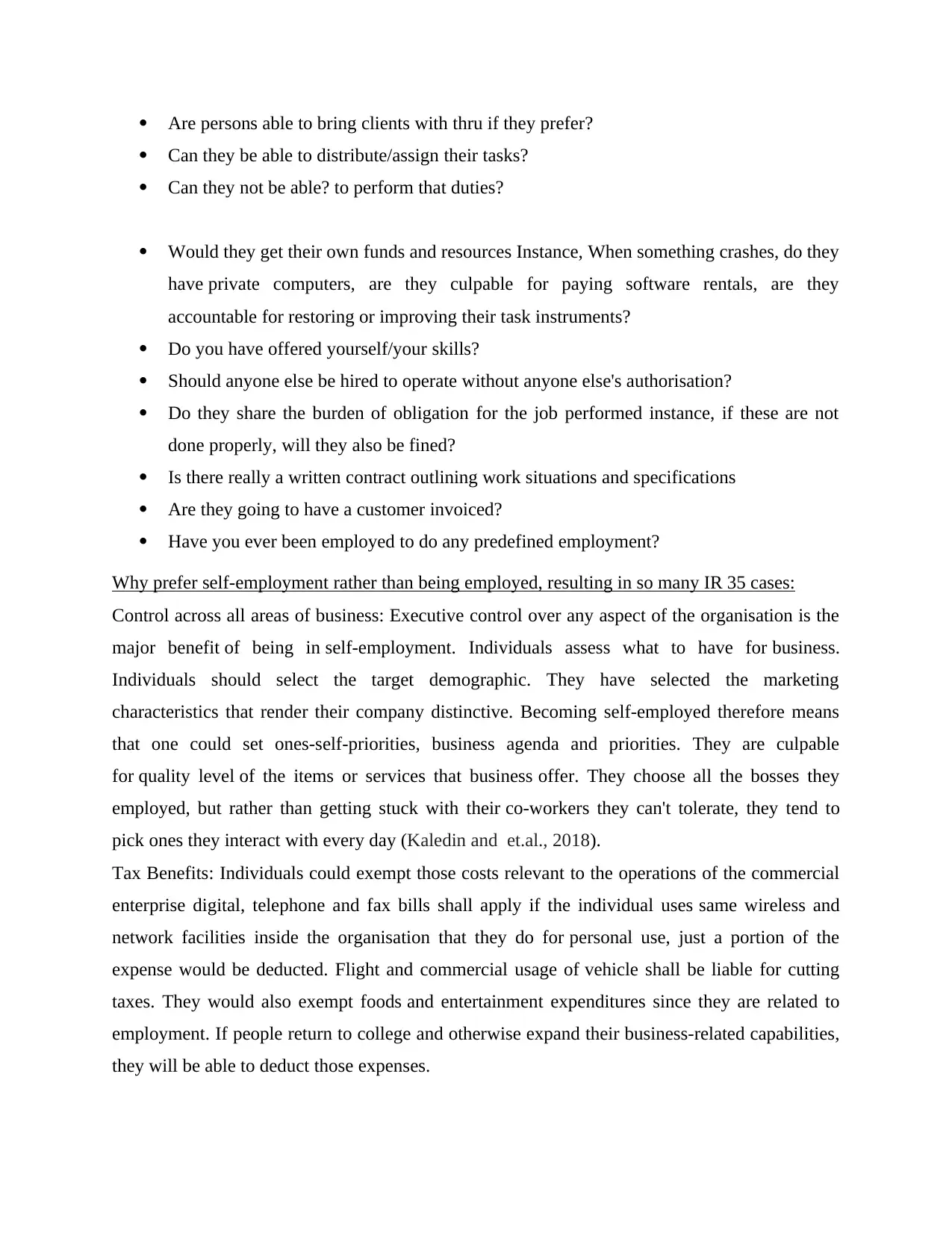
Are persons able to bring clients with thru if they prefer?
Can they be able to distribute/assign their tasks?
Can they not be able? to perform that duties?
Would they get their own funds and resources Instance, When something crashes, do they
have private computers, are they culpable for paying software rentals, are they
accountable for restoring or improving their task instruments?
Do you have offered yourself/your skills?
Should anyone else be hired to operate without anyone else's authorisation?
Do they share the burden of obligation for the job performed instance, if these are not
done properly, will they also be fined?
Is there really a written contract outlining work situations and specifications
Are they going to have a customer invoiced?
Have you ever been employed to do any predefined employment?
Why prefer self-employment rather than being employed, resulting in so many IR 35 cases:
Control across all areas of business: Executive control over any aspect of the organisation is the
major benefit of being in self-employment. Individuals assess what to have for business.
Individuals should select the target demographic. They have selected the marketing
characteristics that render their company distinctive. Becoming self-employed therefore means
that one could set ones-self-priorities, business agenda and priorities. They are culpable
for quality level of the items or services that business offer. They choose all the bosses they
employed, but rather than getting stuck with their co-workers they can't tolerate, they tend to
pick ones they interact with every day (Kaledin and et.al., 2018).
Tax Benefits: Individuals could exempt those costs relevant to the operations of the commercial
enterprise digital, telephone and fax bills shall apply if the individual uses same wireless and
network facilities inside the organisation that they do for personal use, just a portion of the
expense would be deducted. Flight and commercial usage of vehicle shall be liable for cutting
taxes. They would also exempt foods and entertainment expenditures since they are related to
employment. If people return to college and otherwise expand their business-related capabilities,
they will be able to deduct those expenses.
Can they be able to distribute/assign their tasks?
Can they not be able? to perform that duties?
Would they get their own funds and resources Instance, When something crashes, do they
have private computers, are they culpable for paying software rentals, are they
accountable for restoring or improving their task instruments?
Do you have offered yourself/your skills?
Should anyone else be hired to operate without anyone else's authorisation?
Do they share the burden of obligation for the job performed instance, if these are not
done properly, will they also be fined?
Is there really a written contract outlining work situations and specifications
Are they going to have a customer invoiced?
Have you ever been employed to do any predefined employment?
Why prefer self-employment rather than being employed, resulting in so many IR 35 cases:
Control across all areas of business: Executive control over any aspect of the organisation is the
major benefit of being in self-employment. Individuals assess what to have for business.
Individuals should select the target demographic. They have selected the marketing
characteristics that render their company distinctive. Becoming self-employed therefore means
that one could set ones-self-priorities, business agenda and priorities. They are culpable
for quality level of the items or services that business offer. They choose all the bosses they
employed, but rather than getting stuck with their co-workers they can't tolerate, they tend to
pick ones they interact with every day (Kaledin and et.al., 2018).
Tax Benefits: Individuals could exempt those costs relevant to the operations of the commercial
enterprise digital, telephone and fax bills shall apply if the individual uses same wireless and
network facilities inside the organisation that they do for personal use, just a portion of the
expense would be deducted. Flight and commercial usage of vehicle shall be liable for cutting
taxes. They would also exempt foods and entertainment expenditures since they are related to
employment. If people return to college and otherwise expand their business-related capabilities,
they will be able to deduct those expenses.
⊘ This is a preview!⊘
Do you want full access?
Subscribe today to unlock all pages.

Trusted by 1+ million students worldwide
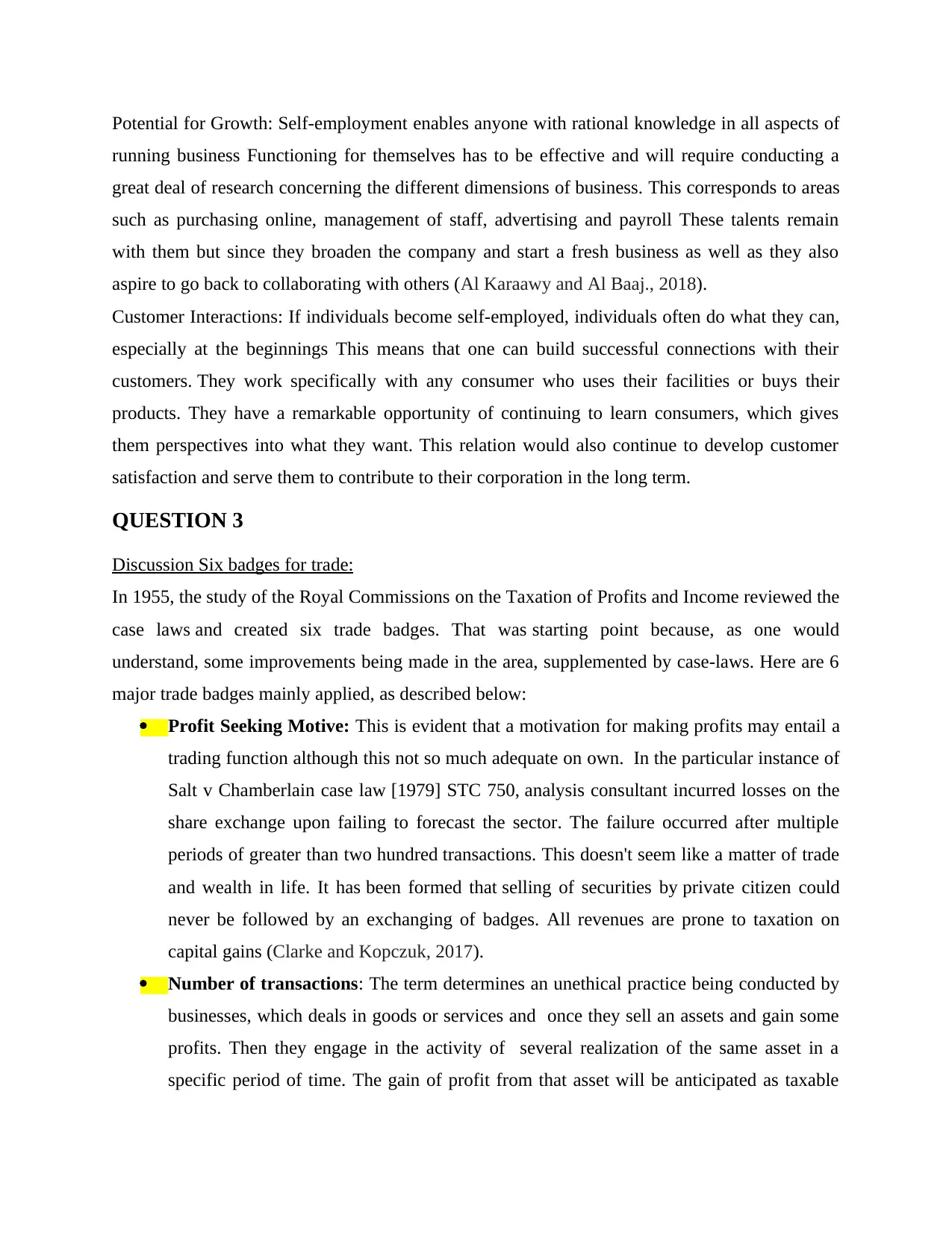
Potential for Growth: Self-employment enables anyone with rational knowledge in all aspects of
running business Functioning for themselves has to be effective and will require conducting a
great deal of research concerning the different dimensions of business. This corresponds to areas
such as purchasing online, management of staff, advertising and payroll These talents remain
with them but since they broaden the company and start a fresh business as well as they also
aspire to go back to collaborating with others (Al Karaawy and Al Baaj., 2018).
Customer Interactions: If individuals become self-employed, individuals often do what they can,
especially at the beginnings This means that one can build successful connections with their
customers. They work specifically with any consumer who uses their facilities or buys their
products. They have a remarkable opportunity of continuing to learn consumers, which gives
them perspectives into what they want. This relation would also continue to develop customer
satisfaction and serve them to contribute to their corporation in the long term.
QUESTION 3
Discussion Six badges for trade:
In 1955, the study of the Royal Commissions on the Taxation of Profits and Income reviewed the
case laws and created six trade badges. That was starting point because, as one would
understand, some improvements being made in the area, supplemented by case-laws. Here are 6
major trade badges mainly applied, as described below:
Profit Seeking Motive: This is evident that a motivation for making profits may entail a
trading function although this not so much adequate on own. In the particular instance of
Salt v Chamberlain case law [1979] STC 750, analysis consultant incurred losses on the
share exchange upon failing to forecast the sector. The failure occurred after multiple
periods of greater than two hundred transactions. This doesn't seem like a matter of trade
and wealth in life. It has been formed that selling of securities by private citizen could
never be followed by an exchanging of badges. All revenues are prone to taxation on
capital gains (Clarke and Kopczuk, 2017).
Number of transactions: The term determines an unethical practice being conducted by
businesses, which deals in goods or services and once they sell an assets and gain some
profits. Then they engage in the activity of several realization of the same asset in a
specific period of time. The gain of profit from that asset will be anticipated as taxable
running business Functioning for themselves has to be effective and will require conducting a
great deal of research concerning the different dimensions of business. This corresponds to areas
such as purchasing online, management of staff, advertising and payroll These talents remain
with them but since they broaden the company and start a fresh business as well as they also
aspire to go back to collaborating with others (Al Karaawy and Al Baaj., 2018).
Customer Interactions: If individuals become self-employed, individuals often do what they can,
especially at the beginnings This means that one can build successful connections with their
customers. They work specifically with any consumer who uses their facilities or buys their
products. They have a remarkable opportunity of continuing to learn consumers, which gives
them perspectives into what they want. This relation would also continue to develop customer
satisfaction and serve them to contribute to their corporation in the long term.
QUESTION 3
Discussion Six badges for trade:
In 1955, the study of the Royal Commissions on the Taxation of Profits and Income reviewed the
case laws and created six trade badges. That was starting point because, as one would
understand, some improvements being made in the area, supplemented by case-laws. Here are 6
major trade badges mainly applied, as described below:
Profit Seeking Motive: This is evident that a motivation for making profits may entail a
trading function although this not so much adequate on own. In the particular instance of
Salt v Chamberlain case law [1979] STC 750, analysis consultant incurred losses on the
share exchange upon failing to forecast the sector. The failure occurred after multiple
periods of greater than two hundred transactions. This doesn't seem like a matter of trade
and wealth in life. It has been formed that selling of securities by private citizen could
never be followed by an exchanging of badges. All revenues are prone to taxation on
capital gains (Clarke and Kopczuk, 2017).
Number of transactions: The term determines an unethical practice being conducted by
businesses, which deals in goods or services and once they sell an assets and gain some
profits. Then they engage in the activity of several realization of the same asset in a
specific period of time. The gain of profit from that asset will be anticipated as taxable
Paraphrase This Document
Need a fresh take? Get an instant paraphrase of this document with our AI Paraphraser
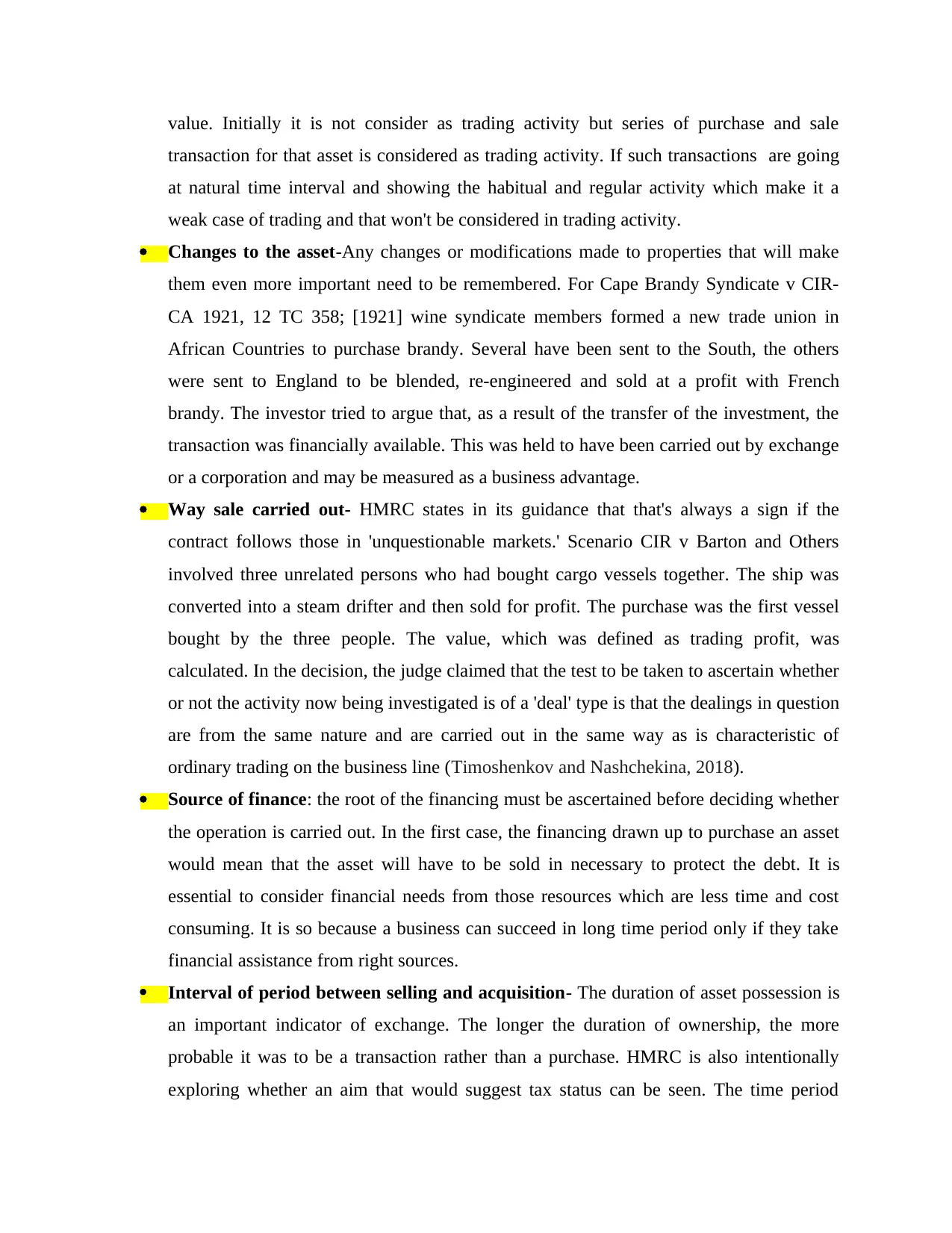
value. Initially it is not consider as trading activity but series of purchase and sale
transaction for that asset is considered as trading activity. If such transactions are going
at natural time interval and showing the habitual and regular activity which make it a
weak case of trading and that won't be considered in trading activity.
Changes to the asset-Any changes or modifications made to properties that will make
them even more important need to be remembered. For Cape Brandy Syndicate v CIR-
CA 1921, 12 TC 358; [1921] wine syndicate members formed a new trade union in
African Countries to purchase brandy. Several have been sent to the South, the others
were sent to England to be blended, re-engineered and sold at a profit with French
brandy. The investor tried to argue that, as a result of the transfer of the investment, the
transaction was financially available. This was held to have been carried out by exchange
or a corporation and may be measured as a business advantage.
Way sale carried out- HMRC states in its guidance that that's always a sign if the
contract follows those in 'unquestionable markets.' Scenario CIR v Barton and Others
involved three unrelated persons who had bought cargo vessels together. The ship was
converted into a steam drifter and then sold for profit. The purchase was the first vessel
bought by the three people. The value, which was defined as trading profit, was
calculated. In the decision, the judge claimed that the test to be taken to ascertain whether
or not the activity now being investigated is of a 'deal' type is that the dealings in question
are from the same nature and are carried out in the same way as is characteristic of
ordinary trading on the business line (Timoshenkov and Nashchekina, 2018).
Source of finance: the root of the financing must be ascertained before deciding whether
the operation is carried out. In the first case, the financing drawn up to purchase an asset
would mean that the asset will have to be sold in necessary to protect the debt. It is
essential to consider financial needs from those resources which are less time and cost
consuming. It is so because a business can succeed in long time period only if they take
financial assistance from right sources.
Interval of period between selling and acquisition- The duration of asset possession is
an important indicator of exchange. The longer the duration of ownership, the more
probable it was to be a transaction rather than a purchase. HMRC is also intentionally
exploring whether an aim that would suggest tax status can be seen. The time period
transaction for that asset is considered as trading activity. If such transactions are going
at natural time interval and showing the habitual and regular activity which make it a
weak case of trading and that won't be considered in trading activity.
Changes to the asset-Any changes or modifications made to properties that will make
them even more important need to be remembered. For Cape Brandy Syndicate v CIR-
CA 1921, 12 TC 358; [1921] wine syndicate members formed a new trade union in
African Countries to purchase brandy. Several have been sent to the South, the others
were sent to England to be blended, re-engineered and sold at a profit with French
brandy. The investor tried to argue that, as a result of the transfer of the investment, the
transaction was financially available. This was held to have been carried out by exchange
or a corporation and may be measured as a business advantage.
Way sale carried out- HMRC states in its guidance that that's always a sign if the
contract follows those in 'unquestionable markets.' Scenario CIR v Barton and Others
involved three unrelated persons who had bought cargo vessels together. The ship was
converted into a steam drifter and then sold for profit. The purchase was the first vessel
bought by the three people. The value, which was defined as trading profit, was
calculated. In the decision, the judge claimed that the test to be taken to ascertain whether
or not the activity now being investigated is of a 'deal' type is that the dealings in question
are from the same nature and are carried out in the same way as is characteristic of
ordinary trading on the business line (Timoshenkov and Nashchekina, 2018).
Source of finance: the root of the financing must be ascertained before deciding whether
the operation is carried out. In the first case, the financing drawn up to purchase an asset
would mean that the asset will have to be sold in necessary to protect the debt. It is
essential to consider financial needs from those resources which are less time and cost
consuming. It is so because a business can succeed in long time period only if they take
financial assistance from right sources.
Interval of period between selling and acquisition- The duration of asset possession is
an important indicator of exchange. The longer the duration of ownership, the more
probable it was to be a transaction rather than a purchase. HMRC is also intentionally
exploring whether an aim that would suggest tax status can be seen. The time period
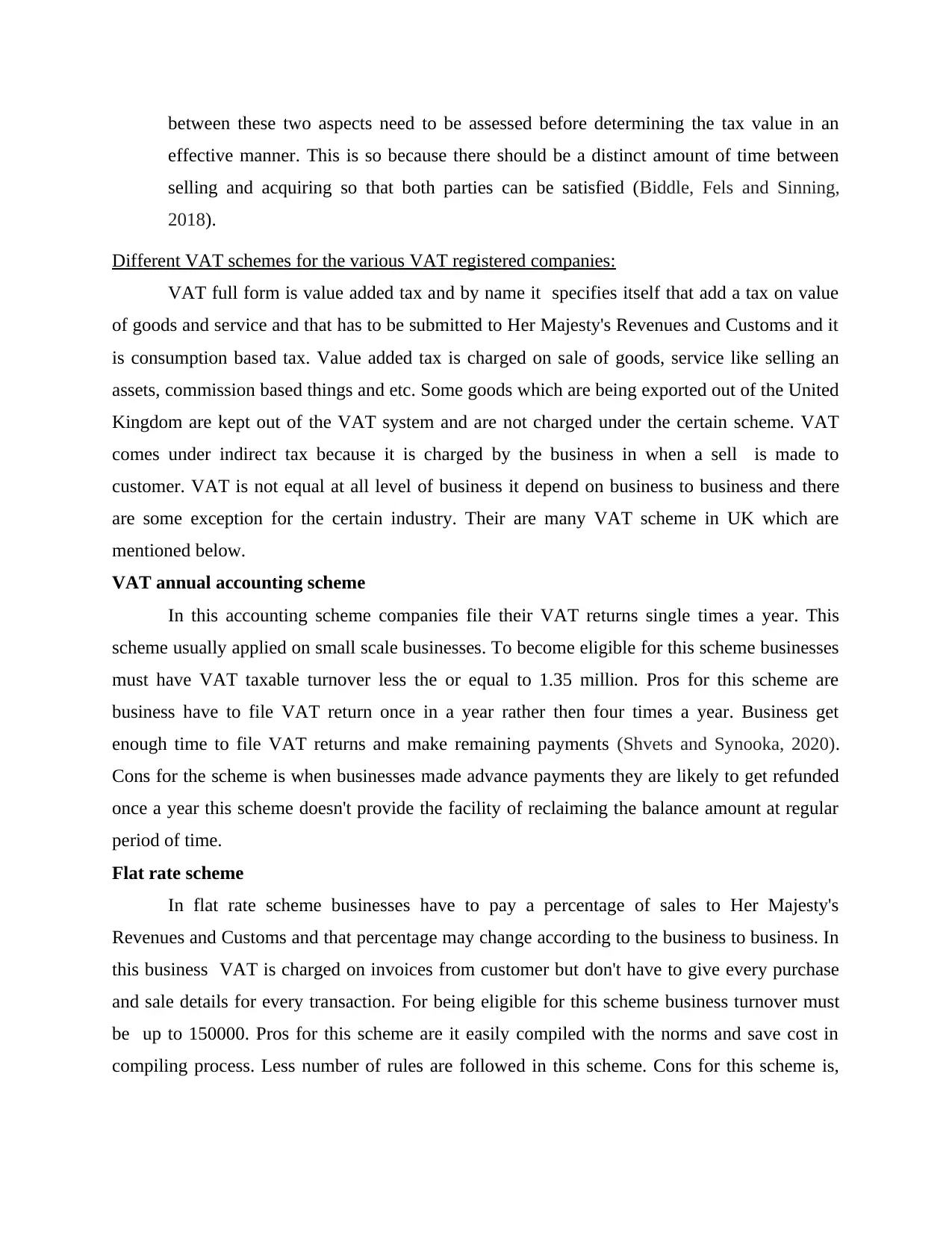
between these two aspects need to be assessed before determining the tax value in an
effective manner. This is so because there should be a distinct amount of time between
selling and acquiring so that both parties can be satisfied (Biddle, Fels and Sinning,
2018).
Different VAT schemes for the various VAT registered companies:
VAT full form is value added tax and by name it specifies itself that add a tax on value
of goods and service and that has to be submitted to Her Majesty's Revenues and Customs and it
is consumption based tax. Value added tax is charged on sale of goods, service like selling an
assets, commission based things and etc. Some goods which are being exported out of the United
Kingdom are kept out of the VAT system and are not charged under the certain scheme. VAT
comes under indirect tax because it is charged by the business in when a sell is made to
customer. VAT is not equal at all level of business it depend on business to business and there
are some exception for the certain industry. Their are many VAT scheme in UK which are
mentioned below.
VAT annual accounting scheme
In this accounting scheme companies file their VAT returns single times a year. This
scheme usually applied on small scale businesses. To become eligible for this scheme businesses
must have VAT taxable turnover less the or equal to 1.35 million. Pros for this scheme are
business have to file VAT return once in a year rather then four times a year. Business get
enough time to file VAT returns and make remaining payments (Shvets and Synooka, 2020).
Cons for the scheme is when businesses made advance payments they are likely to get refunded
once a year this scheme doesn't provide the facility of reclaiming the balance amount at regular
period of time.
Flat rate scheme
In flat rate scheme businesses have to pay a percentage of sales to Her Majesty's
Revenues and Customs and that percentage may change according to the business to business. In
this business VAT is charged on invoices from customer but don't have to give every purchase
and sale details for every transaction. For being eligible for this scheme business turnover must
be up to 150000. Pros for this scheme are it easily compiled with the norms and save cost in
compiling process. Less number of rules are followed in this scheme. Cons for this scheme is,
effective manner. This is so because there should be a distinct amount of time between
selling and acquiring so that both parties can be satisfied (Biddle, Fels and Sinning,
2018).
Different VAT schemes for the various VAT registered companies:
VAT full form is value added tax and by name it specifies itself that add a tax on value
of goods and service and that has to be submitted to Her Majesty's Revenues and Customs and it
is consumption based tax. Value added tax is charged on sale of goods, service like selling an
assets, commission based things and etc. Some goods which are being exported out of the United
Kingdom are kept out of the VAT system and are not charged under the certain scheme. VAT
comes under indirect tax because it is charged by the business in when a sell is made to
customer. VAT is not equal at all level of business it depend on business to business and there
are some exception for the certain industry. Their are many VAT scheme in UK which are
mentioned below.
VAT annual accounting scheme
In this accounting scheme companies file their VAT returns single times a year. This
scheme usually applied on small scale businesses. To become eligible for this scheme businesses
must have VAT taxable turnover less the or equal to 1.35 million. Pros for this scheme are
business have to file VAT return once in a year rather then four times a year. Business get
enough time to file VAT returns and make remaining payments (Shvets and Synooka, 2020).
Cons for the scheme is when businesses made advance payments they are likely to get refunded
once a year this scheme doesn't provide the facility of reclaiming the balance amount at regular
period of time.
Flat rate scheme
In flat rate scheme businesses have to pay a percentage of sales to Her Majesty's
Revenues and Customs and that percentage may change according to the business to business. In
this business VAT is charged on invoices from customer but don't have to give every purchase
and sale details for every transaction. For being eligible for this scheme business turnover must
be up to 150000. Pros for this scheme are it easily compiled with the norms and save cost in
compiling process. Less number of rules are followed in this scheme. Cons for this scheme is,
⊘ This is a preview!⊘
Do you want full access?
Subscribe today to unlock all pages.

Trusted by 1+ million students worldwide
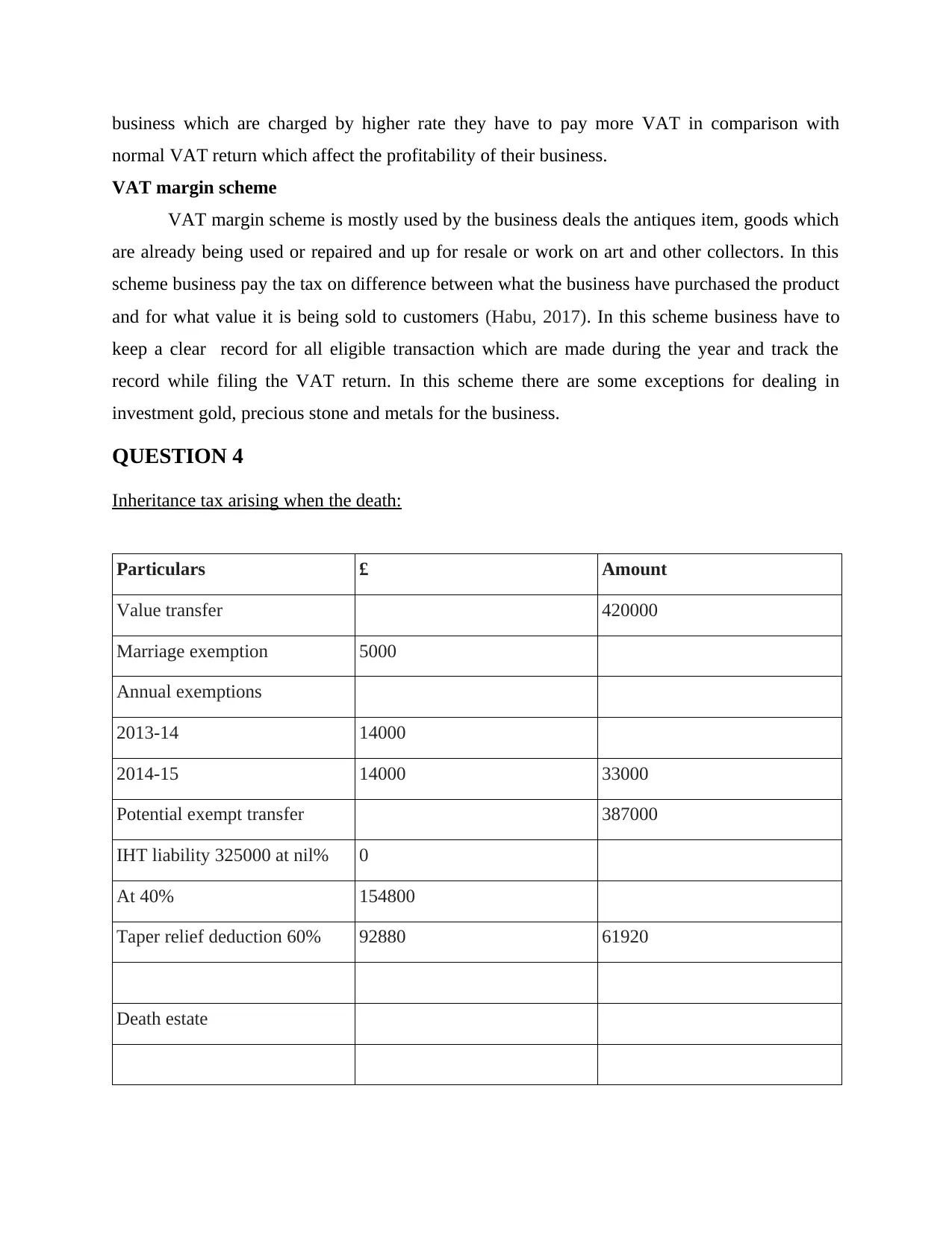
business which are charged by higher rate they have to pay more VAT in comparison with
normal VAT return which affect the profitability of their business.
VAT margin scheme
VAT margin scheme is mostly used by the business deals the antiques item, goods which
are already being used or repaired and up for resale or work on art and other collectors. In this
scheme business pay the tax on difference between what the business have purchased the product
and for what value it is being sold to customers (Habu, 2017). In this scheme business have to
keep a clear record for all eligible transaction which are made during the year and track the
record while filing the VAT return. In this scheme there are some exceptions for dealing in
investment gold, precious stone and metals for the business.
QUESTION 4
Inheritance tax arising when the death:
Particulars £ Amount
Value transfer 420000
Marriage exemption 5000
Annual exemptions
2013-14 14000
2014-15 14000 33000
Potential exempt transfer 387000
IHT liability 325000 at nil% 0
At 40% 154800
Taper relief deduction 60% 92880 61920
Death estate
normal VAT return which affect the profitability of their business.
VAT margin scheme
VAT margin scheme is mostly used by the business deals the antiques item, goods which
are already being used or repaired and up for resale or work on art and other collectors. In this
scheme business pay the tax on difference between what the business have purchased the product
and for what value it is being sold to customers (Habu, 2017). In this scheme business have to
keep a clear record for all eligible transaction which are made during the year and track the
record while filing the VAT return. In this scheme there are some exceptions for dealing in
investment gold, precious stone and metals for the business.
QUESTION 4
Inheritance tax arising when the death:
Particulars £ Amount
Value transfer 420000
Marriage exemption 5000
Annual exemptions
2013-14 14000
2014-15 14000 33000
Potential exempt transfer 387000
IHT liability 325000 at nil% 0
At 40% 154800
Taper relief deduction 60% 92880 61920
Death estate
Paraphrase This Document
Need a fresh take? Get an instant paraphrase of this document with our AI Paraphraser
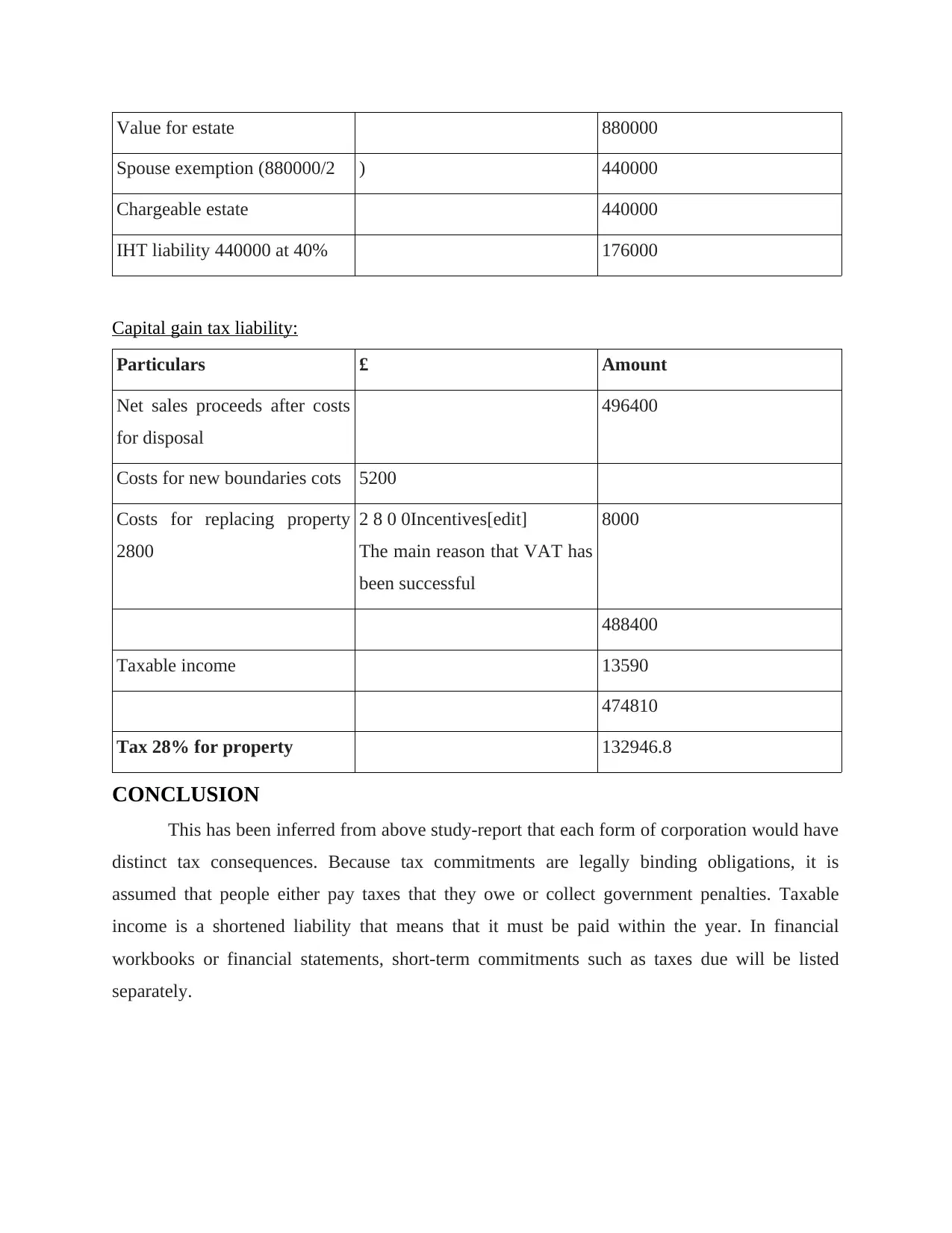
Value for estate 880000
Spouse exemption (880000/2 ) 440000
Chargeable estate 440000
IHT liability 440000 at 40% 176000
Capital gain tax liability:
Particulars £ Amount
Net sales proceeds after costs
for disposal
496400
Costs for new boundaries cots 5200
Costs for replacing property
2800
2 8 0 0Incentives[edit]
The main reason that VAT has
been successful
8000
488400
Taxable income 13590
474810
Tax 28% for property 132946.8
CONCLUSION
This has been inferred from above study-report that each form of corporation would have
distinct tax consequences. Because tax commitments are legally binding obligations, it is
assumed that people either pay taxes that they owe or collect government penalties. Taxable
income is a shortened liability that means that it must be paid within the year. In financial
workbooks or financial statements, short-term commitments such as taxes due will be listed
separately.
Spouse exemption (880000/2 ) 440000
Chargeable estate 440000
IHT liability 440000 at 40% 176000
Capital gain tax liability:
Particulars £ Amount
Net sales proceeds after costs
for disposal
496400
Costs for new boundaries cots 5200
Costs for replacing property
2800
2 8 0 0Incentives[edit]
The main reason that VAT has
been successful
8000
488400
Taxable income 13590
474810
Tax 28% for property 132946.8
CONCLUSION
This has been inferred from above study-report that each form of corporation would have
distinct tax consequences. Because tax commitments are legally binding obligations, it is
assumed that people either pay taxes that they owe or collect government penalties. Taxable
income is a shortened liability that means that it must be paid within the year. In financial
workbooks or financial statements, short-term commitments such as taxes due will be listed
separately.
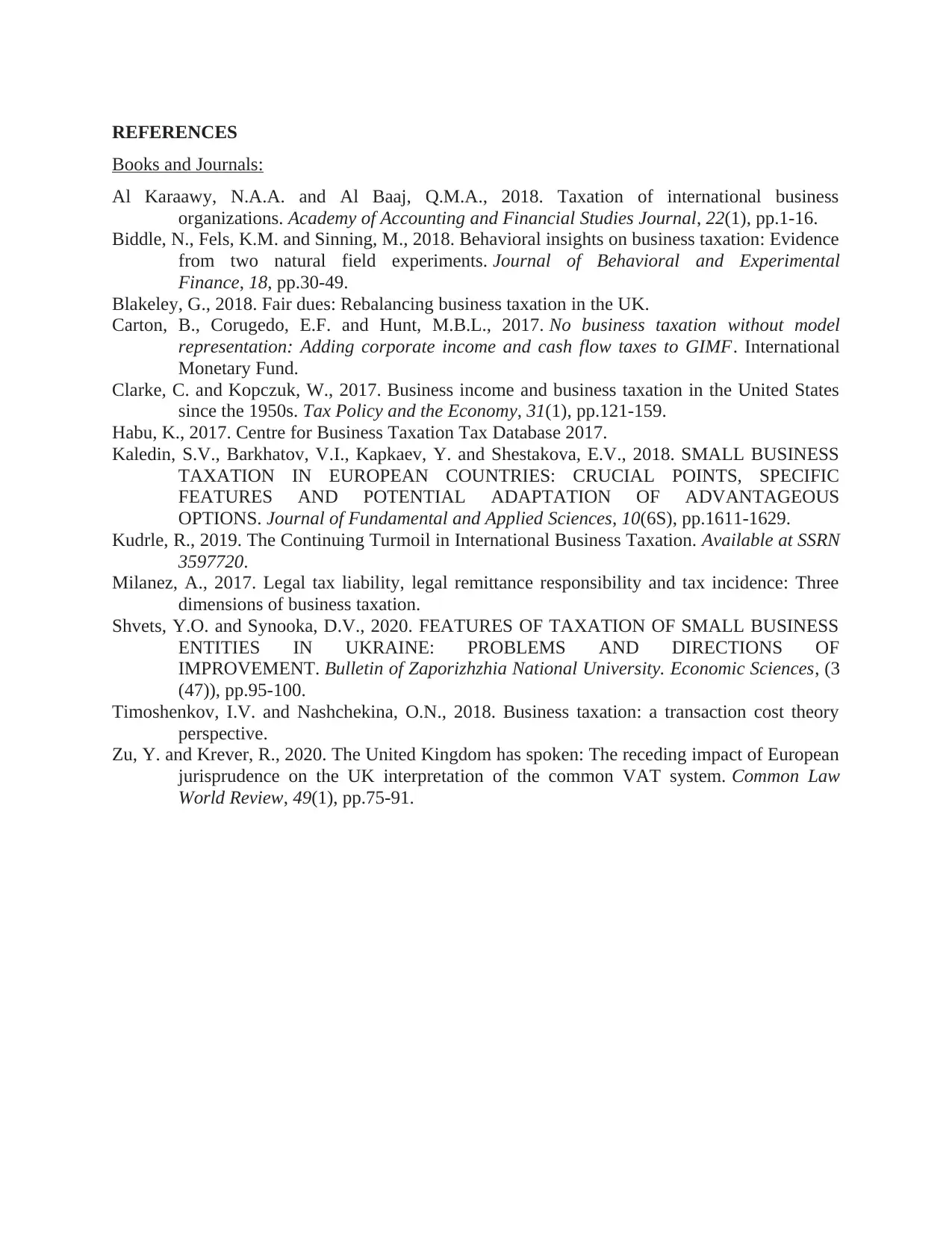
REFERENCES
Books and Journals:
Al Karaawy, N.A.A. and Al Baaj, Q.M.A., 2018. Taxation of international business
organizations. Academy of Accounting and Financial Studies Journal, 22(1), pp.1-16.
Biddle, N., Fels, K.M. and Sinning, M., 2018. Behavioral insights on business taxation: Evidence
from two natural field experiments. Journal of Behavioral and Experimental
Finance, 18, pp.30-49.
Blakeley, G., 2018. Fair dues: Rebalancing business taxation in the UK.
Carton, B., Corugedo, E.F. and Hunt, M.B.L., 2017. No business taxation without model
representation: Adding corporate income and cash flow taxes to GIMF. International
Monetary Fund.
Clarke, C. and Kopczuk, W., 2017. Business income and business taxation in the United States
since the 1950s. Tax Policy and the Economy, 31(1), pp.121-159.
Habu, K., 2017. Centre for Business Taxation Tax Database 2017.
Kaledin, S.V., Barkhatov, V.I., Kapkaev, Y. and Shestakova, E.V., 2018. SMALL BUSINESS
TAXATION IN EUROPEAN COUNTRIES: CRUCIAL POINTS, SPECIFIC
FEATURES AND POTENTIAL ADAPTATION OF ADVANTAGEOUS
OPTIONS. Journal of Fundamental and Applied Sciences, 10(6S), pp.1611-1629.
Kudrle, R., 2019. The Continuing Turmoil in International Business Taxation. Available at SSRN
3597720.
Milanez, A., 2017. Legal tax liability, legal remittance responsibility and tax incidence: Three
dimensions of business taxation.
Shvets, Y.O. and Synooka, D.V., 2020. FEATURES OF TAXATION OF SMALL BUSINESS
ENTITIES IN UKRAINE: PROBLEMS AND DIRECTIONS OF
IMPROVEMENT. Bulletin of Zaporizhzhia National University. Economic Sciences, (3
(47)), pp.95-100.
Timoshenkov, I.V. and Nashchekina, O.N., 2018. Business taxation: a transaction cost theory
perspective.
Zu, Y. and Krever, R., 2020. The United Kingdom has spoken: The receding impact of European
jurisprudence on the UK interpretation of the common VAT system. Common Law
World Review, 49(1), pp.75-91.
Books and Journals:
Al Karaawy, N.A.A. and Al Baaj, Q.M.A., 2018. Taxation of international business
organizations. Academy of Accounting and Financial Studies Journal, 22(1), pp.1-16.
Biddle, N., Fels, K.M. and Sinning, M., 2018. Behavioral insights on business taxation: Evidence
from two natural field experiments. Journal of Behavioral and Experimental
Finance, 18, pp.30-49.
Blakeley, G., 2018. Fair dues: Rebalancing business taxation in the UK.
Carton, B., Corugedo, E.F. and Hunt, M.B.L., 2017. No business taxation without model
representation: Adding corporate income and cash flow taxes to GIMF. International
Monetary Fund.
Clarke, C. and Kopczuk, W., 2017. Business income and business taxation in the United States
since the 1950s. Tax Policy and the Economy, 31(1), pp.121-159.
Habu, K., 2017. Centre for Business Taxation Tax Database 2017.
Kaledin, S.V., Barkhatov, V.I., Kapkaev, Y. and Shestakova, E.V., 2018. SMALL BUSINESS
TAXATION IN EUROPEAN COUNTRIES: CRUCIAL POINTS, SPECIFIC
FEATURES AND POTENTIAL ADAPTATION OF ADVANTAGEOUS
OPTIONS. Journal of Fundamental and Applied Sciences, 10(6S), pp.1611-1629.
Kudrle, R., 2019. The Continuing Turmoil in International Business Taxation. Available at SSRN
3597720.
Milanez, A., 2017. Legal tax liability, legal remittance responsibility and tax incidence: Three
dimensions of business taxation.
Shvets, Y.O. and Synooka, D.V., 2020. FEATURES OF TAXATION OF SMALL BUSINESS
ENTITIES IN UKRAINE: PROBLEMS AND DIRECTIONS OF
IMPROVEMENT. Bulletin of Zaporizhzhia National University. Economic Sciences, (3
(47)), pp.95-100.
Timoshenkov, I.V. and Nashchekina, O.N., 2018. Business taxation: a transaction cost theory
perspective.
Zu, Y. and Krever, R., 2020. The United Kingdom has spoken: The receding impact of European
jurisprudence on the UK interpretation of the common VAT system. Common Law
World Review, 49(1), pp.75-91.
⊘ This is a preview!⊘
Do you want full access?
Subscribe today to unlock all pages.

Trusted by 1+ million students worldwide
1 out of 12
Related Documents
Your All-in-One AI-Powered Toolkit for Academic Success.
+13062052269
info@desklib.com
Available 24*7 on WhatsApp / Email
![[object Object]](/_next/static/media/star-bottom.7253800d.svg)
Unlock your academic potential
Copyright © 2020–2025 A2Z Services. All Rights Reserved. Developed and managed by ZUCOL.





